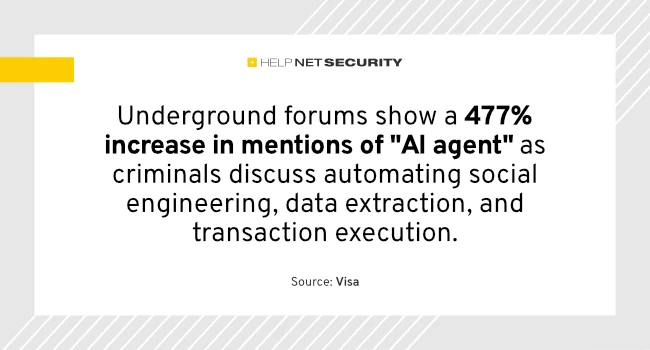Criminal networks industrialize payment fraud operations
Fraud operations are expanding faster than payment defenses can adjust. Criminal groups function like coordinated businesses that develop tools, automate tasks, and scale attacks. New data from a Visa report shows how these shifts are reshaping risk across the financial sector.

Fraud now runs on industrial structures
Criminal groups have moved from scattered activity to organized systems. They reuse infrastructure such as botnets, synthetic identities, and AI driven scripts. Activity on underground forums reflects this shift, including a 477% rise in mentions of AI agents tied to automated social engineering, data extraction, and transaction execution.
Recovered account cases also rose 220% due to large credential dumps that release huge volumes of stolen data at once. These events draw traffic to criminal markets and help sellers build influence. Scam networks rely on repeatable playbooks, rotating through job scams, romance schemes, and investment fraud in a pattern that resembles a production cycle.
Monetization is faster and deliberate
Criminals often hold compromised credentials, then shift into a rapid cash out phase. They rely on instant payments, mobile wallets, and cross border transfers to move funds before institutions can respond.
Some operators use neobank platforms to collect money and exit before victims or investigators react. Token provisioning fraud also benefits from this speed. Scripts test large batches of cards through card on file systems. Once a card is validated, it is used for high value transactions at fraudulent merchants outside the issuing region.
This creates a two phase cycle. The lead up is slow and quiet. The monetization window is fast and structured to finish before controls activate.
Synthetic content weakens identity checks
AI generated material now supports criminal activity across multiple steps. Fake merchant websites, forged documents, and synthetic identities can pass onboarding checks that once filtered out suspicious applicants.
Some fraudulent merchants present themselves as consulting firms, travel services, or government related entities. Their documents and websites appear legitimate, which allows them to clear initial review. Once approved, they process fraudulent transactions under the cover of these categories.
Social engineering has also changed. AI driven conversational agents carry out extended interactions that adapt to a victim’s behavior. These agents create a sense of trust and maintain pressure without human oversight, which makes detection through tone or conversational cues more difficult.
Older controls are losing coverage
Long standing controls were built for slower and visible forms of fraud. Attackers use tactics that spread activity across many merchants and platforms, reducing the effectiveness of traditional detection layers.
“Criminal groups are adapting faster, scaling their operations, and exploiting weaknesses that traditional defenses were never built to handle,” said Visa’s Payment Ecosystem Risk and Control (PERC) team.
Distributed enumeration attacks show this shift. Criminals spread testing across merchants so that each one sees only small amounts of probing traffic, keeping activity below rate limits. Fraudulent merchants also bypass documentation checks because their materials appear legitimate, even when their transactions show patterns associated with abuse.
Threshold based rules, visual checks, and manual reviews struggle under these conditions. Synthetic content and distributed attacks reduce the signals these controls depend on.
Third party weaknesses increase systemic risk
Attacks target processors, service providers, and merchants outside the core banking environments. As financial institutions improve their defenses, criminals turn to connected partners with weaker controls.
From January to June 2025, ransomware incidents affecting payment ecosystem entities rose 41%. During the same period, compromised account distribution through compromised account management system rose 173%. Case counts did not increase at the same rate, but each compromise exposed far more accounts. A small number of large incidents drove most of the risk.
A breach in any connected provider can expose significant amounts of payment data across networks and regions. Consumers trust their bank, although their information is often exposed through merchants or vendors they did not choose.